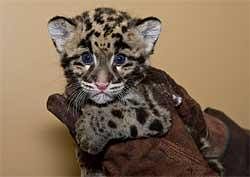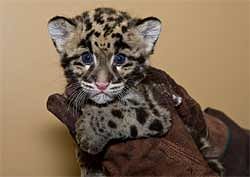

"They are in the last leg of their acclimatisation period accompanied by an animal keeper. In all likelihood, the two male cubs will be released in the wild by the first week of the next month," says Bhaskar Choudhury, a veterinarian with International Fund for Animal Welfare(IFAW) - Wildlife Trust of India (WTI) which is overseeing their rehabilitation.
The duo who would be radio-collared before they are released will be under constant monitoring of the experts for almost an year to ensure their survival instincts in the wild which is usually measured by the way they make kills. "If that happens we can claim that it will be the first successful rehabilitation attempt in the country of the wild cats," says Bhaskar.
The distribution range of the clouded leopard extends into Southeast Asia and is found in the Himalayan foothills in India and Nepal. Bhaskar who has been involved in rehabilitation of Asiatic bears in the past in the region under the IFAW-WTI programme is hoping that the wild cat cubs too would not fail him.
The one-year-old cubs which have fed on bottle-milk seem to be now well-confident and are even making small kills such as chicks in the wild during their acclimatisation period. "They are now almost on their own though at times they do climb the tree or run back towards their animal keeper when confronted with any large predator. They are healthy and active, with each cub now consuming about 250 gms of meat per day," adds Bhaskar.
The cubs, both males, were confiscated from a villager in March last year by a team of Assam Forest Department staff. Less than a month old at the time of rescue, they were handed over to the IFAW-WTI Mobile Veterinary Services (MVS) for hand-raising supported by Bodoland Territorial Council. However, the attempt to release in wild is fraught with several challenges. This arboreal shy creature is facing threat of habitat loss due to widespread deforestation and hunting for use in Chinese medicinal preparations and is listed as "vulnerable to extinction" as a mere 10,000 of them are now left in the wild.
Moreover, various studies have highlighted the low survival rates of captive carnivores that are released into their natural habitats. "On average only one in three captive-born carnivores survives in the wild, with most deaths related to human activities. The animals were also more susceptible to starvation and disease than their wild counterparts and less able to form successful social groups," a study has said.
However, the NGOs are banking on their past experience of successfully release of the seven Asiatic black bear cubs, using the same technique, in Pakke Tiger Reserve in Arunachal Pradesh in collaboration with the forest department. In the recent past, hand-raised rhino and elephant calves have also been released in the wild using the same technique.